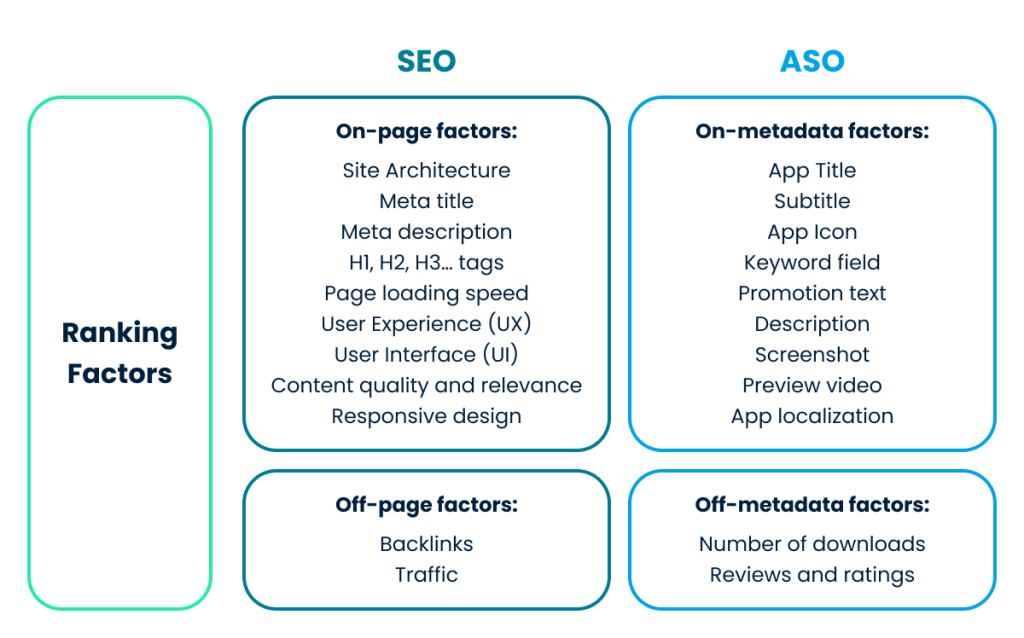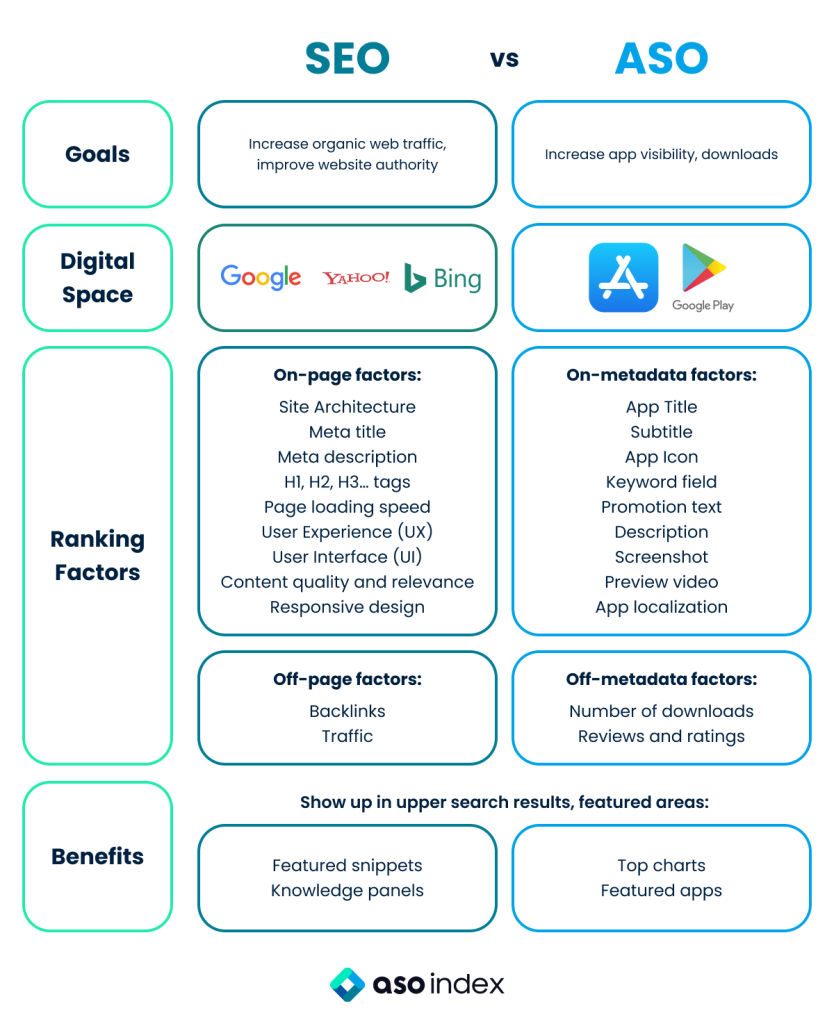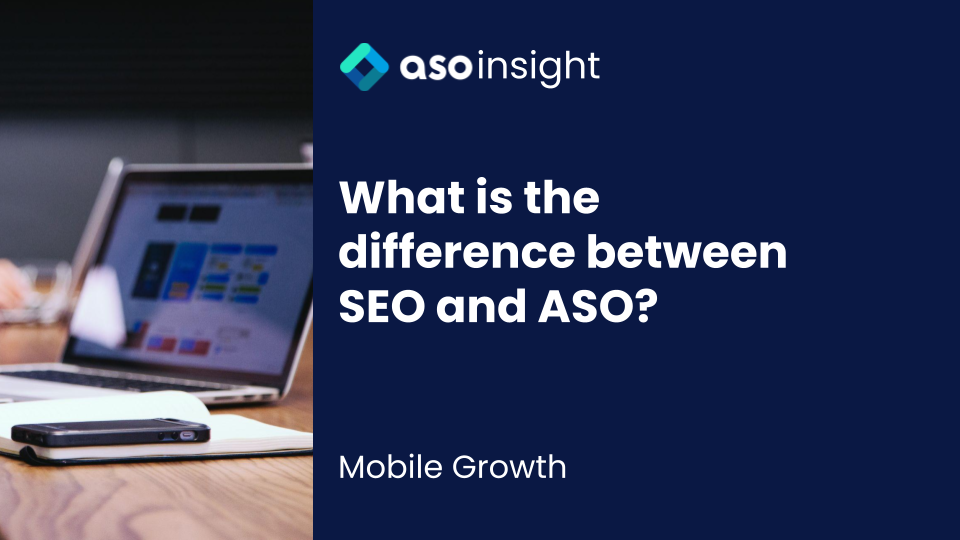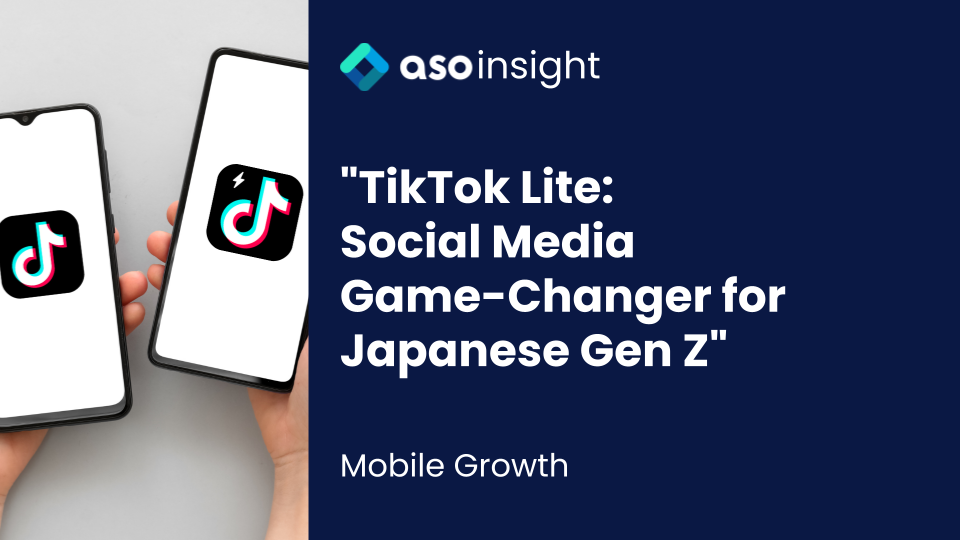Introduction
In today’s digital world, where websites and mobile apps are vying for attention, being visible to potential users is like shining a spotlight on your online presence. Imagine you have a website that offers fantastic content, or an app that solves a real problem, but nobody can find it – that’s where SEO (Search Engine Optimization) and ASO (App Store Optimization) come into play. SEO helps websites rank higher on search engines like Google, making them more discoverable when people search for related topics. On the other hand, ASO works its magic in app stores like the Apple App Store and Google Play Store, ensuring that your app pops up when users are looking for something similar. While these two concepts might seem different, they actually share a strong connection that can supercharge your online success. In this article, we’ll explore how SEO and ASO work hand in hand, like two sides of the same coin, to boost your visibility and reach across the digital landscape.
What is SEO?
SEO, or Search Engine Optimization, lies at the heart of making websites stand out in the digital landscape. It’s all about choosing the right keywords that match what people are searching for and crafting top-notch content that resonates with those keywords. A great user experience is crucial – websites need to load fast, navigate smoothly, and provide value to visitors. On top of that, placing keywords strategically across titles, headings, and content helps search engines understand what the website is all about. Building a network of quality backlinks from reputable sites also signals trustworthiness to search engines. And with mobile devices dominating online usage, having a website that’s user-friendly on phones and tablets is a must.

What is ASO?
ASO, or App Store Optimization, is like SEO’s counterpart but for mobile apps. It’s the process of getting your app noticed in app stores like Apple’s App Store and the Google Play Store. Key factors here include giving your app a clear and relevant name that highlights its main features and using keywords cleverly in the app’s title and description. Visual appeal matters too – an eye-catching app icon and compelling screenshots can draw users in. Positive reviews and ratings are gold, showing potential users that your app is worth their time. Just as websites go multilingual, apps can benefit from localization, adapting their content to different languages and cultures for a broader audience. In essence, while SEO focuses on making websites search-engine-friendly, ASO tailors mobile apps for greater visibility and user engagement within app stores.

Differences and Similarities
Goals

The goals of ASO are centered around enhancing visibility and driving conversions within app stores. This entails maximizing organic downloads of mobile apps while minimizing User Acquisition costs. ASO strategies focus on optimizing app listings, keywords, and user engagement elements to attract users’ attention and encourage downloads. On the other hand, the objectives of SEO (Search Engine Optimization) revolve around improving the visibility of web content. This involves driving organic web traffic to websites and building the authority and credibility of online platforms. SEO efforts include optimizing content quality, keywords, and technical aspects of websites to make them more visible and relevant to search engine users.
Digital Space

SEO (Search Engine Optimization) operates in the broader digital landscape, with its focus on search engines like Google, Yahoo!, Bing, and others. SEO efforts involve optimizing a wide range of online content, including websites, articles, and videos, to achieve greater visibility in search engine results and attract organic web traffic. Conversely, ASO (App Store Optimization) primarily operates within platforms such as the Apple App Store, Google Play Store, and other app marketplaces. ASO strategies are tailored to these specific app store environments to ensure that mobile applications are discoverable and attractive to potential users.
Ranking Factors

When it comes to ranking factors, SEO (Search Engine Optimization), site architecture and technical considerations like meta titles, meta descriptions, header tags (H1, H2, H3…), and page loading speed all play pivotal roles. The user experience (UX), User Interface (UI), content quality, and relevance of the information offered also contribute to SEO success, along with metrics involving user engagement with the content provided. On the other hand, in the realm of ASO (App Store Optimization) hinges on a variety of components within an app’s metadata, encompassing elements like its app title, subtitle, keyword field, description, icon, screenshots, preview video, and promotional text. Furthermore, localization of the app listing, along with the quantity and quality of downloads, user reviews, and ratings, significantly influence ASO rankings.
Benefits

The benefits of SEO and ASO are profound in amplifying visibility and attracting users. SEO ensures your website’s prime placement in search results, garnering attention through featured snippets and knowledge panels. This means more web visitors and higher credibility. On the other hand, ASO secures your app’s prominent position in app store search results and coveted spots on top charts and featured apps sections. This translates to increased app downloads, user trust, and a competitive edge in the crowded app marketplace. In essence, both SEO and ASO are potent tools for enhancing discoverability and driving success in their respective digital domains.
How SEO and ASO can help your app’s growth?
Both SEO and ASO are instrumental in fostering your app’s growth by maximizing its visibility, attracting a larger user base, and driving user engagement. SEO ensures that your app is discoverable beyond the app stores, making it visible to users who search for relevant keywords on search engines. This heightened visibility leads to increased website traffic, potentially driving users to explore your app. SEO’s impact is measured through key performance indicators (KPIs) like organic search traffic, click-through rate (CTR), and conversions, indicating how effectively your website attracts and retains users.
On the other hand, ASO targets users already searching for apps similar to yours within app stores. By optimizing your app’s metadata and visual elements, ASO enhances its presentation and persuades users to download it. ASO’s success is measured through KPIs such as the number of downloads, install rate, and user engagement metrics within the app, reflecting how effectively your app appeals to and retains users once downloaded. Notably, ASO also focuses on increasing impressions, resulting in greater visibility within app stores, and fostering organic conversions—where users discovering your app through ASO take the step to download and engage with it.
In essence, combining the strengths of SEO and ASO provides a comprehensive strategy that covers a wide spectrum of user acquisition channels. By focusing on KPIs specific to each approach, you can effectively monitor, refine, and drive the growth of your app, ensuring increased visibility, user acquisition, and engagement.






